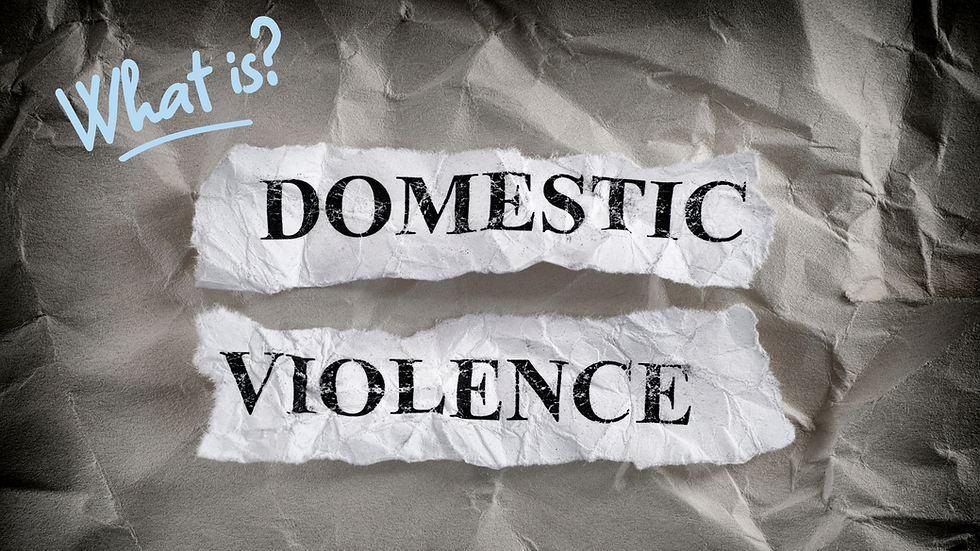What is Domestic Violence?
- Kyle Hall

- May 14, 2024
- 3 min read
Updated: Jul 23, 2024
Domestic violence is a pervasive issue that affects millions of individuals around the world regardless of age, economic status, race, religion, nationality, or educational background. It involves patterns of behavior in a relationship that are used to gain or maintain power and control over an intimate partner. Understanding what constitutes domestic violence, recognizing the warning signs, and knowing how to respond are crucial steps in preventing abuse and supporting victims. This article aims to provide a comprehensive introduction to the topic, exploring its various forms, red flags, and overall impact on individuals and communities.

Understanding Domestic Violence
Domestic violence, also known as intimate partner violence (IPV), domestic abuse, or relationship abuse, encompasses a range of behaviors that one partner uses to exert control over the other. These behaviors can be physical, emotional, sexual, financial, or psychological.
Physical Abuse: This is perhaps the most recognizable form of domestic violence and includes any intentional use of physical force with the intent to cause fear or injury, like hitting, biting, slapping, battering, shoving, punching, or pulling hair.
Emotional Abuse: Emotional or psychological abuse can be more subtle than physical abuse but is equally damaging. It includes insults, threats, intimidation, humiliation, and degradation. It also often involves isolation from friends and family, enforced dependency, and manipulation.
Sexual Abuse: This involves forcing a partner to take part in a sex act when the partner does not consent. This can include rape, attacking sexual body parts, forcing sex after physical violence, or treating one in a sexually demeaning manner.
Financial Abuse: Financial or economic abuse involves controlling a partner’s ability to acquire, use, and maintain financial resources. Abusers may restrict access to funds, conceal information and accessibility to family income, or prevent their partner from working or attending school in order to force dependence.
Psychological Abuse: This involves the use of threats, coercion, and manipulation to instill fear or enforce compliance. It might include threatening to harm oneself, the partner, children, or the partner’s family or friends; destruction of property; or forcing isolation from family, friends, or access to outside assistance.

Recognizing Red Flags and Warning Signs of Domestic Violence
Recognizing the early signs of domestic abuse can prevent escalation and save lives. Here are some common red flags:
Jealousy and Possessiveness: Excessive jealousy, accusations of infidelity, or attempts to isolate a partner from their friends and family.
Control: Overly controlling behavior, including dictating how someone dresses, whom they talk to, or where they go.
Quick Involvement: A whirlwind romance that quickly becomes serious or insists on constant attention and affection.
Unpredictable Mood Swings: Explosive temper, extreme mood swings, or a constant walking on eggshells feeling.
Blaming Others for Problems: Regularly shifting the responsibility and blame to others for one’s own behaviors.
Dual Personality: Drastically different personalities in private and in public.
Threats of Violence: Any threats of physical force meant to control the partner.
Impact of Domestic Violence
The impact of domestic violence is profound and can be long-lasting, affecting the victim’s physical and mental health, their ability to work, and their broader social environment.
Physical Impact: Injuries may range from bruises and broken bones to severe, chronic conditions like cardiovascular disorders or gastrointestinal disorders due to prolonged stress.
Psychological Impact: Victims may suffer from depression, anxiety, post-traumatic stress disorder, substance abuse, and feelings of helplessness and hopelessness.
Economic Impact: Victims often suffer from financial instability due to lost work, medical bills, or the inability to maintain employment.

Supporting Victims and Prevention
Support for victims of domestic violence is available through many channels, including law enforcement, social services, and specialized non-profit organizations. Preventative measures involve educating people about the signs of abuse, promoting healthy relationships, and supporting the enforcement of laws that protect victims and hold abusers accountable.
Conclusion
Domestic violence is a critical issue that demands attention and action. Education, awareness, and community support are key to preventing abuse, protecting victims, and helping them rebuild their lives. By understanding what domestic violence is and recognizing the early signs, we can all contribute to creating safer, healthier environments for everyone.
Resources
For those affected by domestic violence, it is important to know that help is available. National hotlines and local shelters can provide immediate assistance and guide victims toward recovery. Remember, it is never too late to seek help, and you are not alone.

Harmony House
The mission of Harmony House is to provide shelter, advocacy and education to survivors of domestic violence and promote the principle that all individuals have the right to life free of abuse.
Since 1976, our emergency shelter and supportive outreach case management programs have offered individuals and their children the opportunity to rest and heal both emotionally and physically in a supportive environment. We believe you. You are not alone and we can help!
If you or someone you know is living in an abusive situation, call 417–864-SAFE (7233) to speak with an advocate.
.png)